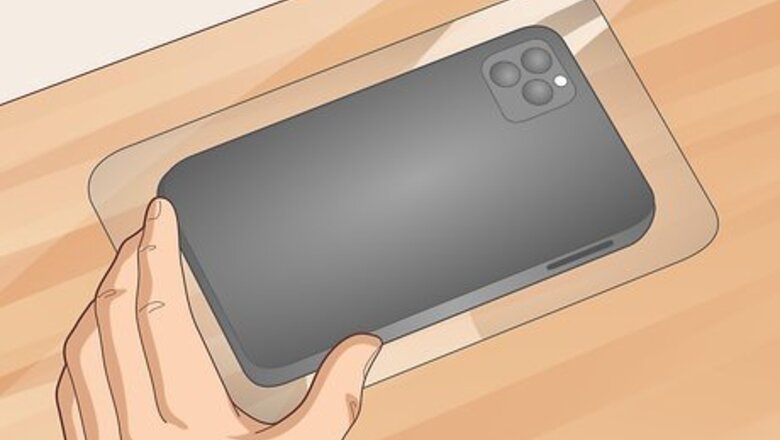
views
- Because the screen protector will likely shatter when you try to cut it, it's better to buy a new screen protector made to fit your screen size.
- Before attempting to cut your screen protector, put on protective eyewear and very thick gloves.
- If you just need to make the screen protector a little smaller, use a diamond file to file the edges down to size.
Sizing the Protector for Your New Phone
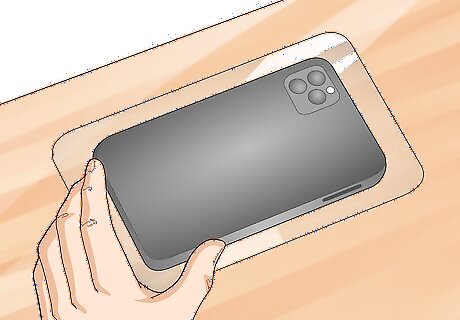
Place your phone upside down on the new protector. Take your screen protector and place it flat on your table or desk. Set the phone down upside down on the screen protector. Line the edges of the protector up so that they’re parallel with the edges of your phone to make cutting easier.Warning: Just as a reminder, the odds are high that your screen protector will shatter when you try to cut it. You can attempt to use either of these methods, but you’re better off just buying a new screen protector if possible. If you’re cutting the screen protector to put it on something other than a phone, simply measure the dimensions and draw them on the screen protector.
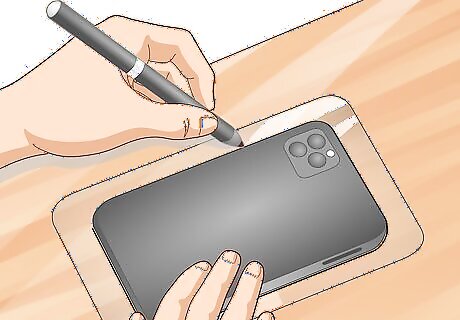
Outline the phone carefully using a thin permanent marker. Grab a fine-tipped permanent marker. Without touching the edges of your phone, carefully outline the phone using the edges as a straight edge. Keep the plastic part of the marker against the phone to avoid getting ink on it. Cover the entire outline of your phone to transfer the size you need to cut on to the screen protector. Add a small notch at the bottom by hand if you have a home button. This notch will be a lot harder to cut out, though.

Put on some thick gloves, a dust mask, and protective eyewear. Regardless of how you are cutting the tempered glass, it’s important to take the proper safety precautions to avoid cutting yourself. Grab the thickest pair of gloves you have, throw on a long sleeve shirt, and get some protective goggles to keep your eyes safe. If you’re cutting the glass underwater to reduce the amount of stress on the glass and minimize the odds that it shatters, you probably don’t need to protect your lungs. If you’re going to trim the screen protector down with a diamond file though, you definitely need a dust mask or respirator to avoid inhaling the dust from the glass.
Trimming the Protector Underwater
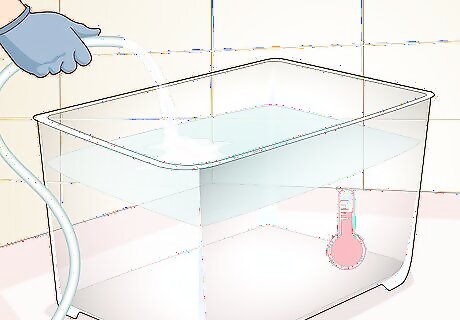
Fill a small bucket or bin with warm water. Grab a container that is large enough for you to submerge both of your hands, your screen protector, and a pair of scissors. A 12 by 12 in (30 by 30 cm) box should be big enough if you have something like that. Fill the bucket up ¾ of the way using warm water from your tap.Warning: This process may not work if you have a thicker screen protector. This process is best for thinner versions that have a little bend in them. This style of screen protector isn’t usually 100% tempered glass, which makes it easier to cut.
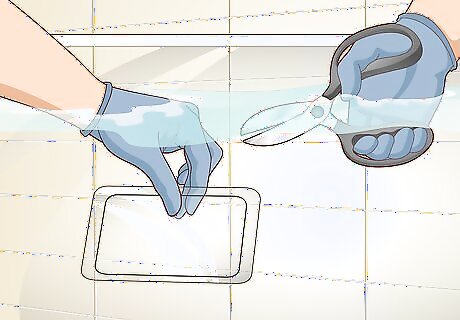
Grab some sharp scissors and submerge the screen underwater. A pair of craft or kitchen scissors probably won’t work for this. Grab a set of strong scissors with sharp blades. Hold the scissors in your dominant hand and submerge them underwater with your screen protector in the other hand. Hold them 2–3 inches (5.1–7.6 cm) below the surface. Don’t take your gloves off to do this. It may feel weird wearing gloves in water, but it’s a key part of staying safe!
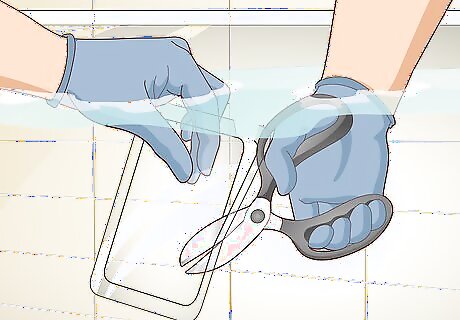
Trim the first side of your outline carefully and slowly. Start on any side of the screen protector. Hold it steady and keep your nondominant fingers at least 2 inches (5.1 cm) away from the cutting line. Carefully cut along the line that you drew on the permanent marker. Go really slow to ensure that you don’t put too much pressure on the screen all at once. It is thought that the water makes it easier to cut the glass by providing a cushion for the glass as you’re cutting it, which it reduces its overall strength and makes it easier to cut. Some people even compare the feeling of cutting glass underwater to cutting cardboard!
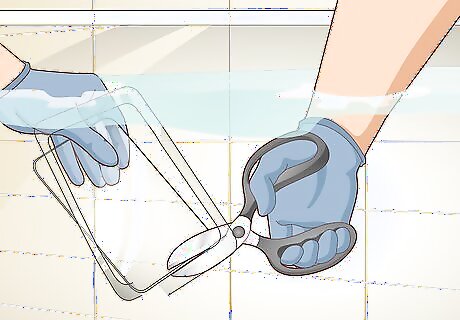
Continue rotating the screen underwater and cut the additional sides. Once you’ve trimmed the first side down, turn the screen protector to the next edge and cut the next side out. Repeat this process for the remaining sides of the screen protector. Cut slowly and work carefully to ensure that you don’t shatter the screen. If you have a notch for your home button, use the portion of the blades that are closest to the handle, not the tips.
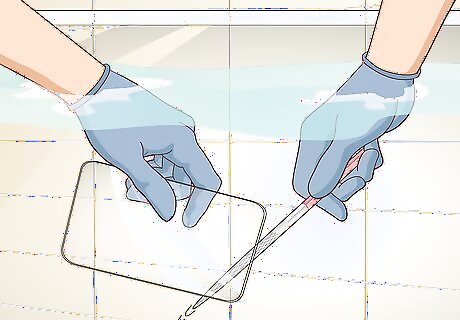
Use a diamond file or dremel to dull the edges underwater. Pick up a diamond file or dremel tool with a buffing tip. Use the flat side of the file to scrape each side of the screen protector using gentle back-and-forth strokes. Do this 10-15 times for each side to smooth the cuts out and remove any loose shards. If you’re using a dremel tool, hold the buffing tip underwater without submerging the tool itself. Turn the tool on and run the tip around the edges of the screen to buff it out. A diamond file is basically a long piece of metal with a textured edge use for sanding hard materials. Diamond files have different grits, just like sandpaper. Use the finest grit you possibly can to do this. A dremel tool is a small, pen-like power tool with a tip that spins. It’s used to trim materials down without cutting. If you use a dremel tool, only submerge the rotating tip in the water to avoid shorting the tool or electrocuting yourself.
Filling Tempered Glass
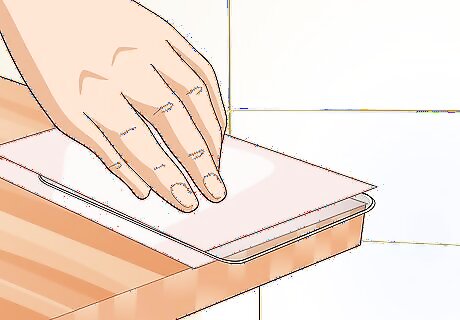
Brace the screen protector near the edge of a table. Lay a sheet of cardboard down near the edge of a table. Put your screen protector on top of the cardboard and hold one of the edges you’re filing 1–2 inches (2.5–5.1 cm) off of the table. Place another sheet of cardboard on top of the screen protector to keep shards of glass from flying everywhere if the screen breaks.Warning: This is not a good idea if you need to remove more than ⁄4–⁄8 inch (0.64–0.32 cm). This process will work if you’re trying to remove a small amount of glass to make a screen fit better, but it will eventually shatter if you remove too much glass.
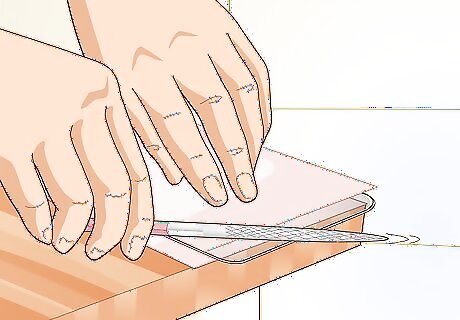
Run the diamond file gently against the edge, parallel to your outline. Get a diamond file in the finest grit you have access to. Brace the top of the screen gently with your nondominant hand. Then, hold the file flat against the side you’re sanding down. Slowly and carefully move the file back and forth. It may take 2-3 minutes to remove enough glass to reach the line you drew on the screen protector. You have to be very delicate while you’re doing this. If you apply too much pressure, the screen protector may shatter. You could theoretically use a dremel instead of a diamond file for this, but it will take a lot longer since you can only work in ⁄2 inch (1.3 cm) sections with the small dremel bit. Your line likely won’t be as clean either.
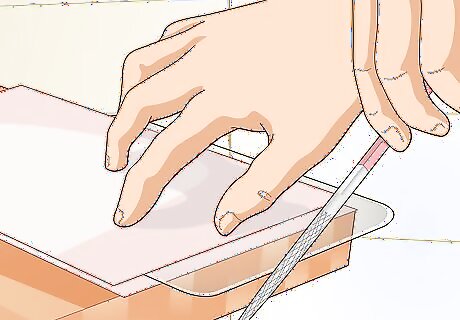
Continue filing the screen protector down until it matches your outline. Once you’ve filed down your first side, lift the cardboard up and rotate your screen protector so that a new side rests 1–2 inches (2.5–5.1 cm) over the edge. File this side down the same way you did the first side. Repeat this process for each of the additional sides until you’ve removed all of the excess glass. You don’t need to sand the edges down since the diamond file is basically doing this for you as you remove the glass.


















Comments
0 comment